Southwell Minster
Southwell Minster (/ˈsʌðəl, ˈsaʊθwəl, -wɛl/)[1][2][3] is a minster and cathedral, in Southwell, Nottinghamshire, England. It is situated six miles from Newark-on-Trent and thirteen miles from Mansfield. It is the seat of the Bishop of Southwell and Nottingham and the Diocese of Southwell and Nottingham.
| Southwell Minster | |
|---|---|
| Cathedral and Parish Church of the Blessed Virgin Mary | |
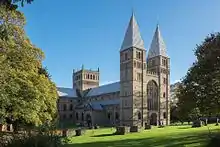 | |
 Southwell Minster Shown within Nottinghamshire | |
| Location | Southwell, Nottinghamshire |
| Country | United Kingdom |
| Denomination | Church of England |
| Website | www.southwell minster.org.uk |
| Architecture | |
| Style | Romanesque, Gothic |
| Years built | c.1108-c1300 |
| Specifications | |
| Number of towers | 3 |
| Number of spires | 2 |
| Administration | |
| Diocese | Southwell and Nottingham (since 1884) |
| Province | York |
| Clergy | |
| Bishop(s) | Paul Williams |
| Dean | Nicola Sullivan |
| Precentor | Richard Frith |
| Canon Chancellor | vacant |
History
Middle Ages
The earliest church on the site is believed to have been founded in 627 by Paulinus, the first Archbishop of York, when he visited the area while baptising believers in the River Trent. The legend is commemorated in the Minster's baptistry window.[4]
In 956 King Eadwig gave land in Southwell to Oskytel, Archbishop of York, on which a minster church was established. The Domesday Book of 1086 recorded the Southwell manor in great detail. The Norman reconstruction of the church began in 1108, probably as a rebuilding of the Anglo-Saxon church, starting at the east end so that the high altar could be used as soon as possible and the Saxon building was dismantled as work progressed. Many stones from this earlier Anglo-Saxon church were reused in the construction. The tessellated floor and late 11th century tympanum in the north transept are the only parts of the Anglo-Saxon building remaining intact. Work on the nave began after 1120 and the church was completed by c.1150.[5]
The church was originally attached to the Archbishop of York's Palace which stood next door and is now ruined. It served the archbishop as a place of worship and was a collegiate body of theological learning, hence its designation as a minster. The minster draws its choir from the nearby school with which it is associated.[6]
The Norman chancel was square-ended. For a plan of the original church see Clapham (1936).[7] The chancel was replaced with another in the Early English style in 1234–51 because it was too small. The octagonal chapter house, built starting in 1288 with a vault in the Decorated Gothic style has naturalistic carvings of foliage (the 13th-century stonecarving includes several Green Men). The elaborately carved "pulpitum" or choir screen was built in 1320–40.[5]
Reformation and civil war
The church suffered less than many others in the English Reformation as it was refounded in 1543 by Act of Parliament.[8]
Southwell is where Charles I was captured during the English Civil War, in 1646. The fighting saw the church seriously damaged and the nave is said to have been used as stabling. The adjoining palace was almost completely destroyed, first by Scottish troops and then by the local people, with only the Hall of the Archbishop remaining as a ruined shell.[9] The Minster's financial accounts show that extensive repairs were necessary after this period.
18th century
On 5 November 1711 the southwest spire was struck by lightning, and the resulting fire spread to the nave, crossing and tower destroying roofs, bells, clock and organ.[10]:118 By 1720 repairs had been completed, now giving a flat panelled ceiling to the nave and transepts.
Victorian
In 1805 Archdeacon Kaye gave the Minster the Newstead lectern; once owned by Newstead Abbey, it had been thrown into the Abbey fishpond by the monks to save it during the Dissolution of the Monasteries, then later discovered when the lake was dredged.[11] Henry Gally Knight in 1818 gave the Minster four panels of 16th century Flemish glass (which now fill the bottom part of the East window) which he had acquired from a Parisian pawnshop.[12]
In danger of collapse, the spires were removed in 1805 and re-erected in 1879–81 when the minster was extensively restored by Ewan Christian, an architect specialising in churches. The nave roof was replaced with a pitched roof[13] and the choir was redesigned and refitted.
Ecclesiastical history
Collegiate church
Southwell Minster was served by prebendaries from the early days of its foundation. By 1291 there were 16 Prebends of Southwell mentioned in the Taxation Roll.[14]:19–20
In August 1540, as the dissolution of the monasteries was coming to an end, and despite its collegiate rather than monastic status, Southwell Minster was suppressed specifically in order that it could be included in the plans initiated by King Henry VIII to create several new cathedrals. It appears to have been proposed as the see for a new diocese comprising Nottinghamshire and Derbyshire, as a replacement for Welbeck Abbey which had been dissolved in 1538 and which by 1540 was no longer owned by the Crown.[15][16]
The plan for the minster's elevation did not proceed, so in 1543 Parliament reconstituted its collegiate status as before. In 1548 it again lost its collegiate status under the 1547 Act of King Edward VI which suppressed (among others) almost all collegiate churches: at Southwell the prebendaries were given pensions and the estates sold, while the church continued as the parish church on the petitions of the parishioners[14]:32.
By an Act of Philip and Mary in 1557, the minster and its prebends were restored. In 1579 a set of statutes was promulgated by Queen Elizabeth I and the chapter operated under this constitution until it was dissolved in 1841[14]:36-38. The Ecclesiastical Commissioners made provision for the abolition of the chapter as a whole; the death of each canon after this time resulted in the extinction of his prebend. The chapter came to its appointed end on 12 February 1873 with the death of Thomas Henry Shepherd, rector of Clayworth and prebendary of Beckingham.[17]
Cathedral
In 1884 Southwell Minster became a cathedral proper for Nottinghamshire and a part of Derbyshire including the city of Derby[10]:126–127. The diocese was divided in 1927 and the Diocese of Derby was formed.[18][19] The diocese's centenary was commemorated by a royal visit to distribute Maundy money. George Ridding, the first Bishop of Southwell, designed and paid for the grant of Arms now used as the diocesan coat of arms.[20]
Architecture
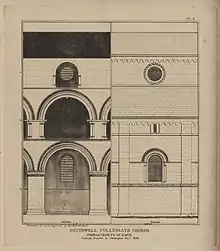
The nave, transepts, central tower and two western towers of the Norman church which replaced the Saxon minster remain as an outstanding achievement of severe Romanesque design. With the exception of fragments mentioned above, they are the oldest part of the existing church.
The Nave is of seven bays, plus a separated western bay. The columns of the arcade are short and circular, with small scalloped capitals. The triforium has a single large arch in each bay. The clerestory has small round-headed windows. The external window openings are circular. There is a tunnel-vaulted passage between the inside and outside window openings of the clerestory. The nave aisles are vaulted, the main roof of the nave is a trussed rafter roof, with tie-beams between each bay – a late C19 replacement.[5][22][23]
By contrast with the nave arcade, the arches of the crossing are tall, rising to nearly the full height of the nave walls. The capitals of the east crossing piers depict scenes from the life of Jesus.[24] Two stages of the inside of the central tower can be seen at the crossing, with cable and wave decoration on the lower order and zigzag on the upper. The transepts have three stories with semi-circular arches, like the nave, but without aisles.[5]

The western facade has pyramidal spires on its towers – a unique feature today, though common in the C12.[5] The existing spires date only from 1880, but they replace those destroyed by fire in 1711, which are documented in old illustrations.[25] The large west window dates from the C15.[5] The central tower's two ornamental stages place it high among England's surviving Norman towers. The lower order has intersecting arches, the upper order plain arches. The north porch has a tunnel vault, and is decorated with intersecting arches.[5]
The choir is Early English in style, and was completed in 1241. It has transepts, thus separating the choir into a western and eastern arm. The choir is of two stories, with no gallery or triforium. The lower storey has clustered columns with multiform pointed arches, the upper storey has twin lancet arches in each bay. The rib vault of the choir springs from clustered shafts which rest on corbels. The vault has ridge ribs. The square east end of the choir has two stories each of four lancet windows.[5]
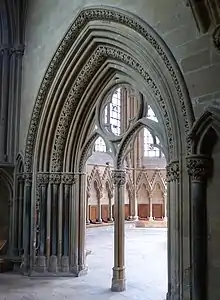


In the 14th century the chapter house and the choir screen were added. The chapter house, started in 1288, is in an early decorated style, octagonal, with no central pier. It is reached from the choir by a passage and vestibule, through an entrance portal. This portal has five orders, and is divided by a central shaft into two subsidiary arches with a circle with quatrefoil above. Inside the chapter house, the stalls fill the octagonal wall sections, each separated by a single shaft with a triangular canopy above. The windows are of three lights, above them two circles with trefoils and above that a single circle with quatrefoil[5][10]:87–105. This straightforward description gives no indication of the glorious impression, noted by so many writers[10]:91, of the elegant proportions of the space, and of the profusion (in vestibule and passage, not just in the chapter house) of exquisitely carved capitals and tympana, mostly representing leaves in a highly naturalistic and detailed representation. The capitals in particular are deeply undercut, adding to the feeling of realism. Individual plant species such as ivy, maple, oak, hop, hawthorn can often be identified. The botanist Albert Seward published a detailed description of the carvings and their identification in 1935[26] and Nikolaus Pevsner wrote the classic description entitled The Leaves of Southwell, with photographs by Frederick Attenborough, in 1945.[27]
The rood screen dates from 1320 to 1340, and is an outstanding example of the Decorated style.[5] It has an east and west facade, separated by a vaulted space with flying ribs. The east facade, of two stories, is particularly richly decorated, with niches on the lower story with ogee arches, and openwork gables on the upper storey. The central archway rises higher than the lower storey, with an ogee arch surmounted by a cusped gable.[5]
The finest memorial in the minster is the alabaster tomb of Edwin Sandys, Archbishop of York (died 1588).[23]
Staff
Dean and chapter
As of 1 January 2021:[28]
- Dean — Nicola Sullivan (since 17 September 2016 installation)
- Canon Chancellor – position vacant
- Canon Precentor – Richard Frith (since 8 September 2019)[29]
Other clergy
- Priest Vicar and Canon Theologian (honorary canon) — Alison Milbank
- Priest Vicar – Tony Evans
- Priest Vicar – Erika Kirk
- Chaplain to the Minster School — position vacant
Lay staff
- Rector Chori – Paul Provost
- Assistant Director of Music – Jonathan Allsopp
- Organ Scholar – James Furniss-Roe
- Head Verger – Andrew Todd
Music and liturgy
Much of the worship at the minster is led by the Cathedral Choir, a traditional choir of boys and men, directed by the Rector Chori ("The Ruler of the Choir"), [Paul Provost]. Choristers are educated at the The Minster School, which is unusual among choir schools as it is in the state sector. The choir has attracted international attention when previous head chorister Ben Inman, formed the Choirboys, a "boy band" comprising three cathedral choristers. There is a girls' choir and the adult Minster Chorale. The minster follows the rites of the Church of England and uses the 1662 Book of Common Prayer for Choral Eucharist on Sunday. The Friends of Cathedral Music was founded in 1956 by Ronald Sibthorpe prompted by a decision of the provost to abolish Saturday choral evensong so that lay clerks could watch football at Newark-on-Trent.[30]
Choirs
In recent years, the choir has broadcast on BBC Radio 3, recorded CDs, toured in Europe, filmed Christmas programmes and given world premières of specially commissioned works such as Paul Patterson's Southwell Millennium Mass. The choir has appeared before the Queen, sung with the Royal Philharmonic Orchestra, the Orchestra of St John's, Smith Square and the London Festival Orchestra. In 2003 the Minster Choir joined the choirs of Westminster Cathedral and St Albans Cathedral for a concert in the St Albans International Organ Festival. Ted Heath, former Prime Minister, wrote "I cannot recall a more impressive programme of church music in many recent years. My deepest congratulations for an evening the richness of which will last for ever".
There are usually 16 choristers in the Cathedral Choir. As with most choirs there is a hierarchical ranking system, in this case of Head Chorister; Deputy Head Chorister; Corner Boys; Senior Singing Boys; Junior Singing Boys and Probationers. The ranks of corner boy upwards are entitled to wear a 'tippet', a very short red cloak which is worn over the surplice. There are also Juniors who do not sing with the full choir, but are training to become full choristers.
There are six full-time professional lay clerks in the choir supplemented by six men on alternate Sunday evenings and on special occasions, expanding the repertoire and force of the choir. The lay clerks often perform in their own right in services.
The Minster Girls' Choir was formed in February 2005 by the Assistant Organist Simon Bell. It is made up of 18 choristers, under the direction of Simon Hogan. The girls are drawn from the Minster School. They sing at the 9.30am Family Eucharist on Sundays once per month and at Evensong every Monday at 5.45pm.
The choir's repertoire consists of music written for upper voices and includes music by composers such as Jean Langlais, Charles Wood and George Dyson. In September 2007, the choir sang a commissioned anthem by Andrew Parnell, a former chorister at Southwell, as part of the service of installation of the Dean. The choir's first tour was to Stavanger in Norway in October 2009, followed by another in 2013 to Amsterdam. In 2011 it released a CD, Christus Rex – a selection of music from Lent to Ascension, including Leighton's Easter Sequence, directed by Philip White-Jones and accompanied by Jonathan Turner with Richard Pratt, trumpet.
The Minster Chorale is an adult choir that sings at services throughout the year. It consists of up to thirty members who rehearse on Friday evenings. Currently directed by the Assistant Director of Music, the chorale was founded in 1994 by Philip Rushforth and Paul Hale.
The choir sings a cross-section of the whole repertoire of traditional cathedral music, including works by Palestrina, Byrd, Mozart, Stanford and Howells. It deputises for the Minster Choir at half-term, and sings at many evening Eucharist services on high feast days, such as Ash Wednesday, Maundy Thursday and Ascension Day. The Chorale takes its share of Christmas duties, singing at Midnight Mass.
The chorale is invited to perform occasional concerts and services away from the minster. It has sung in Rievaulx Abbey, St Mary's Collegiate Church in Warwick and Uppingham Parish Church. In July 2005, the chorale sang a services at Christ Church Cathedral, Dublin. In summer 2011, it joined with the Voluntary Choir of Rochester Cathedral to celebrate the music of Rochester composers such as Robert Ashfield, Barry Ferguson and Percy Whitlock.
List of Rectores Chori
|
|
|
To see the list of organists, assistant directors of music and organ scholars, see the list of musicians at English cathedrals.
Southwell Music Festival
The Minster is also home to the annual Southwell Music Festival, held in late August.
Image gallery
Ground plans of the Minster
 Plan of the Minster 1839
Plan of the Minster 1839 Plan of vestibule and passage to the chapter house
Plan of vestibule and passage to the chapter house Plan of the chapter house
Plan of the chapter house
Exterior
 The west front
The west front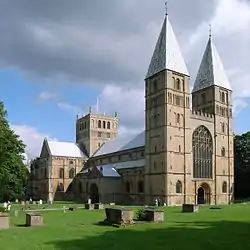 The Minster from the NW
The Minster from the NW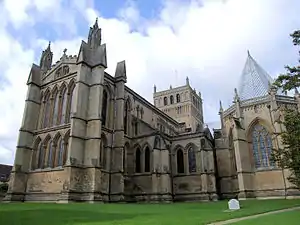 The Minster from the NE
The Minster from the NE Door of south transept
Door of south transept Central tower, north transept, north porch, and chapter house
Central tower, north transept, north porch, and chapter house
Nave and Transepts
 The Norman nave, built in the early 12th century
The Norman nave, built in the early 12th century Nave with the font on the right side
Nave with the font on the right side.jpg.webp) Nave of the Minster
Nave of the Minster
Choir
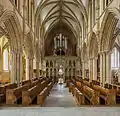 Pulpitum and choir, looking west to the nave
Pulpitum and choir, looking west to the nave High altar and east window of choir
High altar and east window of choir One of the misericords in the quire
One of the misericords in the quire
Chapter House
 Carvings on the left side of the portal arch of the chapter house
Carvings on the left side of the portal arch of the chapter house Chapter house portal capitals, right side
Chapter house portal capitals, right side The stalls and canopies of the chapter house
The stalls and canopies of the chapter house Chapter house capital showing hops
Chapter house capital showing hops Chapter house stall canopy tympanum showing green man
Chapter house stall canopy tympanum showing green man
Windows
 Presepe Window
Presepe Window Window
Window Great War Memorial Window by Nicholas Mynheer
Great War Memorial Window by Nicholas Mynheer
Old illustrations
 Southwell Minster before the original spires were destroyed by fire in 1711
Southwell Minster before the original spires were destroyed by fire in 1711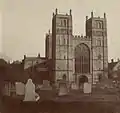 Southwell Minster without the spires, which were removed in 1805 and replaced in 1879-81
Southwell Minster without the spires, which were removed in 1805 and replaced in 1879-81 The central tower and transepts
The central tower and transepts Bays of the choir
Bays of the choir Chapter House Portal 1801
Chapter House Portal 1801
See also
- Architecture of the medieval cathedrals of England
- List of Gothic Cathedrals in Europe
- English Gothic architecture
- Romanesque architecture
- Church of England
- Southwell Preparatory School a private Anglican primary and intermediate school in Hamilton, New Zealand named after the town and cathedral.[31]
References
- Jones, Daniel (edited by Peter Roach and James Hartman) (1997). English Pronouncing Dictionary (15th ed.). Cambridge University Press. p. 462.
- Upton, C., Kretzschmar, W. & Konopka, R., eds. (2001). Oxford Dictionary of Pronunciation for Current English. Oxford University Press. p. 980. ISBN 0-19-863156-1.CS1 maint: multiple names: authors list (link) CS1 maint: extra text: authors list (link)
- Wells, J C (1990). Longman Pronunciation Dictionary. Longman. p. 663.
- As mentioned by Daniel Defoe, (who visited in 1725) in his journal A tour thro' the Whole Island of Great Britain
- Pevsner, Nikolaus; Williamson, Elizabeth (1979). The Buildings of England: Nottinghamshire. Second edition, reprinted 1997 with corrections. London: Penguin Books. pp. 319–333. ISBN 0-14-071002-7.
- "Southwell:mMinster: The Cathedral Choir". Retrieved 17 August 2019.
- Clapham, Alfred William (1936). Romanesque Architecture in Western Europe. Oxford: Clarendon Press. Figure 45.
- Leach, Arthur Francis (1891). Visitations and Memorials of Southwell Minster. Camden Society. p. xcvii.
- Summers, Norman (1974). A prospect of Southwell : an architectural history of the church and domestic buildings of the collegiate foundation. London: Phillimore. p. 55. ISBN 0-85033-181-1.
- Dimock, Arthur (1898). The cathedral church of Southwell, a description of its fabric and a brief history of the episcopal see. London: George Bell & Sons.
- Cormack, Patrick (1984). English cathedrals. Weidenfeld and Nicolson. ISBN 0297784145.
- Thorold, Henry (1986). Collins guide to cathedrals, abbeys, and priories of England and Wales. HarperCollins. ISBN 0002172410.
- Transactions of the Thoroton Society of Nottinghamshire: Volumes 76–77, 1973
- Livett, Greville Mairis (1883). Guide to Southwell Minster with a history of the College of Secular Canons. Southwell: John Whittingham.
- Jeffery, Paul (2004). The Collegiate Churches of England and Wales. London: Robert Hale ISBN 0-7090-7412-3 pp.37, 263–267
- Jeffery, Paul (2012). England's Other Cathedrals. Port Stroud: The History Press ISBN 978-0-7524-5347-7 pp.71–72, 74–75
- Page, William, ed. (1910). "Colleges: The collegiate church of Southwell. In: A History of the County of Nottingham: Volume 2". British History Online. London: Victoria County History. pp. 152–161. Retrieved 17 August 2019.
- Beckett, John (2012). "The Victorian Church of England in the Midlands: The Founding of the Diocese of Southwell, 1876–1884". Midland History. 37 (1): 63–83. doi:10.1179/0047729X12Z.0000000003.
- "History of the Diocese". The Diocese of Derby. Retrieved 18 August 2019.
- Ridding, Laura (1908). George Ridding: Schoolmaster and Bishop, Forty-third Head Master of Winchester, 1866–1884, First Bishop of Southwell 1884–1904. London: Edward Arnold. p. 174.
- Killpack, William Bennett (1839). The history and antiquities of the collegiate church of Southwell. London: Simpkin, Marshall and Co.
- Thompson, A. Hamilton (1911). "Autumn Excursion: Visit to Southwell". Transactions of the Thoroton Society. XV.
- Little, Bryan (1972). English Cathedrals in Colour. London: Batsford. pp. 140–43.
- "St Mary, Southwell, Nottinghamshire". The corpus of romanesque sculpture in Britain and Ireland. Retrieved 17 August 2019.
- Dugdale, William (1655). Monasticon anglicanum, or, The history of the ancient abbies, monasteries, hospitals, cathedral and collegiate churches, with their dependencies in England and Wales. Londini: Typis Richardi Hodgkinsonne.
- Seward, Albert Charles (1935). "The Foliage, Flowers and Fruit of Southwell Chapter House" (PDF). Proceedings of the Cambridge Antiquarian Society. 35: 1–32.
- Pevsner, Nikolaus (1945). The Leaves of Southwell. London: King Penguin.
- Webweaver (11 February 2019). "Appointment of Canon Precentor, Southwell Minster". Southwell Minster. Retrieved 22 November 2019.
- Barrett 2010
- "Archived copy" (PDF). Archived from the original (PDF) on 3 June 2010. Retrieved 8 September 2010.CS1 maint: archived copy as title (link)
External links
| Wikimedia Commons has media related to Southwell Minster. |